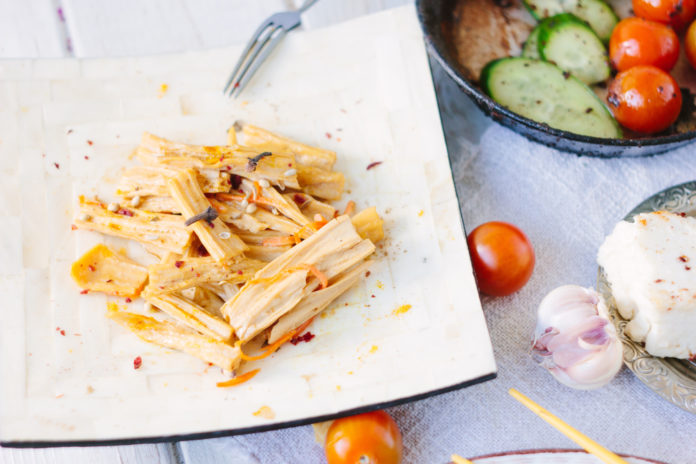Soybean-produced tofu and soymilk are well-known and awfully familiar, though its distant relative may be overlooked. Also known as tofu skin, the Japanese-originating yuba is gaining attention worldwide and becoming integrated into modern cuisine. But what exactly is yuba and the benefits it offers? Yubatter believe we have the inside scoop and are showing you how to use it!
What Is Yuba?
Also known as tofu skin and bean curd, yuba is produced from soybeans. While its preparation is slightly time-consuming, it really is not so complicated. Think of the process as bringing a pot of milk to a simmer on the stovetop for your next cup of hot chocolate. But rather than discarding or mixing the coagulated proteins that forms at the top (and using dairy milk and adding the cocoa), the by-product is preserved. Nonetheless, yuba is the skin that forms on the surface as soy milk cooks and its proteins and fats rise to the surface, is used in various dishes, and showing to be quite beneficial.
How Might You Benefit from Yuba?
Most of the benefit of yuba comes down to its favorable nutritional profile, high versatility, and inclusion in a variety of diets, including those following a vegetarian or vegan lifestyle or these desiring or requiring low-carb, grain-free, gluten-free, and dairy-free options. A single ounce of tofu skin is touted to supply a mere 18 calories, 1 gram of fat, 1 gram of carb, and 2 grams of plant-based protein. Yuba is also a rich source of iron, calcium, and other essential vitamins and minerals. It’s low-calorie, nutrient-dense profile can support a healthy weight, along with promoted benefits of soy to prevent certain chronic diseases like diabetes, high blood pressure, and certain types of cancers such as breast and prostate. Consuming soy-based products regularly may also lower bad cholesterol (LDL) and reduces symptoms associated with menopause.
How to Use Yuba
Yuba often comes in two forms, including dried and fresh varieties. While dried yuba requires rehydration and delivers a spongy texture, fresh yuba is suggested to be tender, slightly stretchy, and offer a clean, fresh flavor. Yuba is available for purchase in stores particularly thanks to Hodo, which claims itself as “as the only maker of fresh, organic, non-GMO, fresh yuba in the US marketplace.” But along with in-store yuba products, you can also make it in the comfort of your own home with this tofu skin recipe! But whether store-bought or homemade, common yuba foods and recipes include:
Fried Bean Curds
In one of yuba’s most simplest and enjoyed forms… Fried bean curds! All you need to do is fry up yuba sheets for 20 seconds and drain. Dip into sweet chili sauce for a quick appetizer or crunch up and top onto salads and soups.
Yuba Wraps
Shanghainese call these yuba wraps “Vegetarian Goose,” which is a traditional dish they often serve as an appetizer.
Yuba Rolls
And known as “neutralized duck” in Buddhist cooking, these yuba rolls are meant to recreate the taste and texture of roasted duck. But the rolls are somewhat quackery, as they are purely plant-based and vegetarian-friendly!
Yuba Noodle Salad
This yuba noodle salad bursts with fresh ingredients and flavors, including from the tofu skin itself, cilantro, carrots, cabbage, and green salads. And not to mention, the smooth and creamy dressing drizzled atop!
Spicy Yuba Stir-Fry with Edamame
Crispy and spicy, this yuba food recipe is intensifying in flavor and texture! Feel free to incorporate extra stir-fry favorites, including mushroom, egg, and beef sirloin.
Tofu Skin Knots
Whereas yuba is customarily used in Asian cuisine, these tofu skin knots are inspired by French flavors and modestly, and interestingly, resemble the flavors of BBQ. (Yubatter believe these knots are explosive in flavor!)
Yuba Cheesesteak
(Well, without the cheesesteak!) This tofu skin recipe is a vegan-friendly alternative to traditional cheesesteaks, as “Thick sheets of yuba are sliced and smothered in an umami-packed mushroom broth before tossing with caramelized onions and roasted trumpet mushrooms.”








